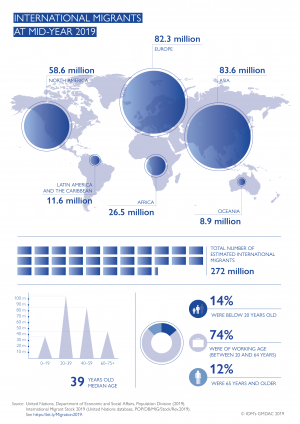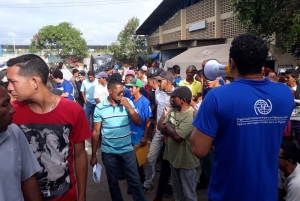Until the beginning of the 1980s, intra-regional migration was more prevalent than migration to other regions. Later, during the 1990s flows from South America started to head to more developed countries (the United States and European countries). However, after the 2008 international crisis this trend changed and intra-regional regained a considerable dynamism.
Fact #1: Intra-regional migration has been growing at a faster pace than emigration to more developed countries, but with an uncertain future
This changing migratory pattern was initially explained by the convergence of two sets of factors: (1) the impacts of the financial crisis of 2008 for immigrants in the more developed world, and the adoption of more restrictive immigration policies; and (2) the positive developments in South America, particularly in terms of migration policies and growing employment opportunities. More recently, since 2016, another circumstance fueled intraregional migration: the significant emigration from the Bolivarian Republic of Venezuela. The extremely difficult socio-economic and political situation has been pushing out a massive flow of people out of the country, increasing the already growing number of intraregional migrants.
Nowadays in South America, the number of intra-regional immigrants is converging with the number of South American emigrants residing elsewhere in the world. The United Nations Department of Economic and Social Affairs (UN DESA)'s Population Division estimates that in 2019 there were 7,786,568 international migrants from South American countries residing outside the region and 6,091,023 within the region. Therefore, the relative size between these two groups decreased from 1.9 to 1.3. However, it is important to note that a significant slow-down in most South American economies as a result of the adoption of structural adjustment policies and recent episodes of social unrest in several countries, such as Chile, the Plurinational State of Bolivia, Ecuador and Colombia, raise the question of how migration will evolve in the near future. For example, since 2016, immigration to Spain has grown and not exclusively due to emigrants from the Bolivarian Republic of Venezuela. Annual South American inflows to Spain increased more than threefold from 75,851 in 2015 to 256,210 in 2018.
Figure 1: Immigrant stocks from South America residing within and outside the region (1990, 2000, 2010 and 2019)
Source: Based on United Nations Department of Economic and Social Affairs (UN DESA), Population Division (2019). International Migrant Stock 2019 (United Nations database, POP/DB/MIG/Stock/Rev.2019).
Fact #2: Intra-regional migration flows increased in numbers and became more diversified in terms of origins, destinations and migrants' socio-demographic profiles
For decades, Argentina and the Bolivarian Republic of Venezuela were the main immigrant receiving countries in the region, but this situation has changed. Intra-regional migration diversified even before massive emigration from Venezuela, and even though Argentina continues to have its predominant role. In Chile, immigration almost tripled in a decade. In Ecuador immigration grew considerably mainly due to its dollarized economy and the violence experienced in Colombia; and in Uruguay, a traditionally emigration country, immigration almost double as well.
Yet, Colombia and Peru have been the countries that experienced the most sudden changes. In both, emigration had traditionally constituted a significant component of their demographic dynamic, until very recently when they started receiving massive inflows of immigrants, refugee and asylum seekers from the Bolivarian Republic of Venezuela.
Figure 2: South American migration: numbers of regional emigrants and immigrants by country, 2019
Source: Based on United Nations Department of Economic and Social Affairs (UN DESA), Population Division (2019). International Migrant Stock 2019 (United Nations database, POP/DB/MIG/Stock/Rev.2019).
Source: Based on United Nations, Department of Economic and Social Affairs (UN DESA). Population Division (2019). International Migrant Stock 2019 (United Nations database, POP/DB/MIG/Stock/Rev.2019).
It is important to mention that according to data from the Coordination Platform for Refugees and Migrants from Venezuela (a regional Inter-Agency Coordination Platform comprising the United Nations High Commissioner for Refugees (UNHCR) and the International Organization for Migration (IOM), the numbers of emigrants from the Bolivarian Republic of Venezuela in South America is much larger (about 3.7 million). Consequently, it is very likely that numbers of intraregional immigrants would be considerably larger than those reported by UN DESA estimates.
Diversification of migration corridors also has involved immigration from other continents, such as Asia and Africa (for example to Argentina and Ecuador). Even though the size of these flows is considerably smaller, they face more difficulties in terms of social integration.
Fact #3: Regional agreements that govern international migration in South America have favoured integration and the protection of migrants' rights
A salient trait of the South American region was a conceptual change in the way migration should be managed. Since the beginning of the twenty first century, through regional, bi-national and multilateral agreements, and the adaptation of national laws and regulations, migrants' mobility and access to residency rights have considerably improved.
An indicator of this process is the high number of residencies, temporary and permanent, granted recently. Between 2017 and 2018, South American countries granted 484,612 permanent residence permits and 1,352,887 temporary residence permits.
Having access to resident rights has promoted the economic and social integration of immigrants, particularly in relation to access to formal employment and public social services.
Fact #4: South American countries have responded rapidly to emigration from the Bolivarian Republic of Venezuela
In a very short period, many countries in the region received large numbers of Venezuelans, who in massive groups concentrated around border areas and other receiving locations with poor resources. It has been estimated that the crisis gave rise to 4,626,968 refugees, migrants and asylum seekers worldwide (although more than two thirds reside in the region). The situation generated a series of public health risks, and many people were forced to travel by precarious and unsafe routes, in particular for women and children. Yet host countries have had a solidary reaction and offered an open-door policy generating various mechanisms in order to provide not only emergency assistance but also regular documents.
The Regional Inter-Agency Coordination Platform also provides estimates on the number residency permits granted to citizens from the Bolivarian Republic of Venezuela in the region. South American countries responded to this crisis by providing a large number of residence permits and regular stays: 1,948,771. In South American countries a considerable number of asylum seekers were also registered (537,473).
Figure 4: Regional response to massive emigration from the Bolivarian Republic of Venezuela: Residence permits and regular stays granted (January 2020)
Source: R4V, Coordination Platform for Refugees and Migrants from Venezuela. Regional Inter-Agency Coordination Platform, UNHCR and IOM, https://r4v.info/es/situations/platform (extracted 30/01/2020).
Fact #5: Women predominate among South American migrants and play a significant role in the domestic and care sectors
Among intraregional migrants there are 108 women for every 100 men.
Figure 5: Female-male ratios in intra-regional migration by country of destination
Source: Based on data from Economic Commission for Latin America and the Caribbean, ECLAC, IMILA database (https://celade.cepal.org/bdcelade/imila December, 2019) corresponding to population Censuses of Argentina (2010), Bolivia (2010), Brazil (2010), Ecuador (2010), Uruguay (2011) and the Bolivarian Republic of Venezuela (2011). Census information for Chile (2017) and Peru (2017) obtained from National Statistical Offices.
Challenges and prospects
Different migratory patterns characterize South America today. Regarding intraregional migration, corridors have increased and diversified. The recent large movement of refugees, migrants and asylum seekers from the Bolivarian Republic of Venezuela require significant efforts by receiving countries to provide social, educational and health services, and to ensure tolerant and respectful environments. Even though the region has taken exemplary measures to govern migration by favoring regular migration, there is still considerable room for improvements in relation to migrants’ integration.
Challenges regarding the social, economic and cultural integration of immigrants in the region extends to immigrants from other regions such as Asia and Africa. These movements are not included in regional agreements that favored residency rights and deserve particular attention by governments.
Some political turns in the region raise some doubts of how this process will evolve in the future. It is therefore important for the international community as well as national civil society organizations to be alert and to closely monitor whether governments comply with their regional commitments towards international migrants.
Finally, a recently observed trend of increasing emigration to Spain also calls for a closer look at how the economic and political crisis affects the dynamic of migration, particularly in relation to a migration aspect that has been overlooked, that is the nature and characteristics of re-emigration processes.
Based on data provided by Argentina, Dirección Nacional de Migraciones; Brazil, Ministério da Justiça and Departamento de Polícia Federal; Bolivia, Dirección General de Migración; Chile, Dirección de Extranjería y Migración; Colombia, Migración Colombia, Ministerio de Relaciones Exteriores; Ecuador, Ministerio de Relaciones Exteriores y de Movilidad Humana; Paraguay, Dirección General de Migraciones; Perú, Superintendencia Nacional de Migraciones; Uruguay, Dirección Nacional de Migración-Ministerio del Interior and Ministerio de Relaciones Exteriores.





